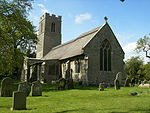Ant Broads & Marshes National Nature Reserve
National nature reserves in EnglandNature reserves in NorfolkNorfolk Broads
Ant Broads & Marshes NNR is a national nature reserve in Norfolk, England established by English Nature. It is named after the River Ant. It is part of the "Ant Broads and Marshes" Site of Special Scientific Interest and is within The Broads National Park. The NNR includes: Barton Broad and Catfield Fen, owned and managed by Norfolk Wildlife Trust Catfield Fen Reserve, owned and managed by the British Butterfly Conservation Society.The fen is the best example of unpolluted valley fen in Western Europe.
Excerpt from the Wikipedia article Ant Broads & Marshes National Nature Reserve (License: CC BY-SA 3.0, Authors).Ant Broads & Marshes National Nature Reserve
Barton Broad Boardwalk, North Norfolk Barton Turf
Geographical coordinates (GPS) Address Nearby Places Show on map
Geographical coordinates (GPS)
| Latitude | Longitude |
|---|---|
| N 52.73864 ° | E 1.49604 ° |
Address
Nancy Oldfield Trust
Barton Broad Boardwalk
NR12 8XR North Norfolk, Barton Turf
England, United Kingdom
Open on Google Maps








